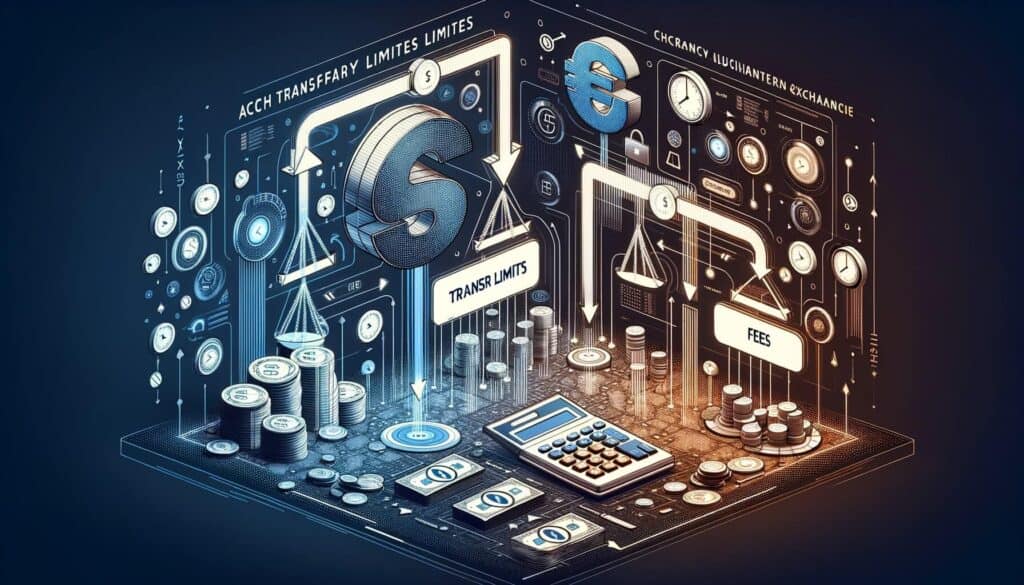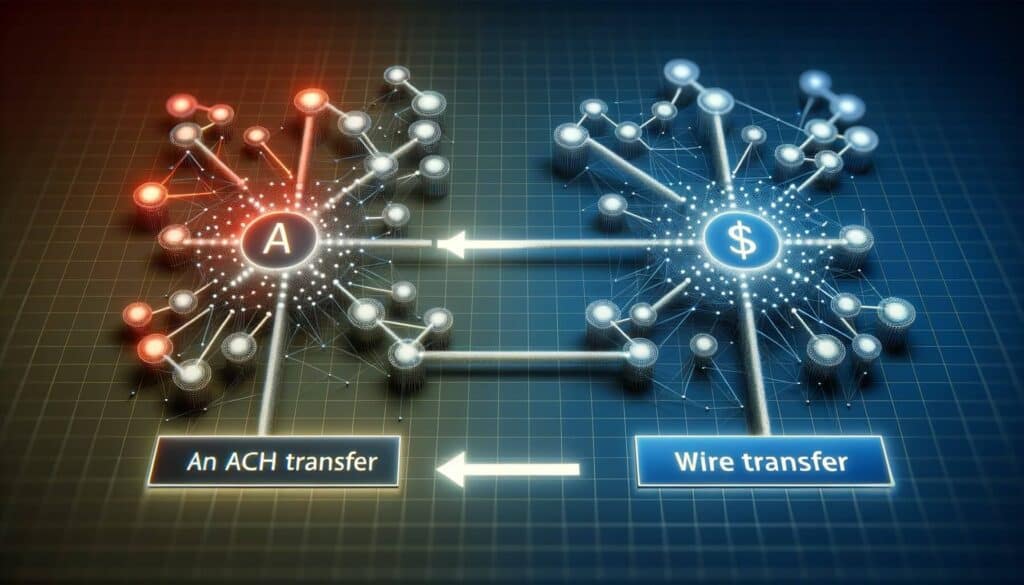
By Cindy Gardea January 12, 2025
In today’s digital age, electronic payment systems have become an integral part of our daily lives. One such system is the Automated Clearing House (ACH) transfer, which allows individuals and businesses to send and receive funds electronically. ACH transfers offer a convenient, secure, and cost-effective alternative to traditional paper-based transactions.
This comprehensive guide aims to provide a detailed understanding of Automated Clearing House (ACH) transfers, including how they work, their benefits, step-by-step initiation process, transfer limits and fees, comparison with wire transfers, security measures, troubleshooting tips, and common FAQs.
Understanding the ACH Network

The ACH network is a highly regulated system that processes a vast number of transactions daily. It is managed by the National Automated Clearing House Association (NACHA), a not-for-profit organization that establishes and enforces the rules and standards for ACH transactions. According to NACHA, in 2020, the ACH network processed over 26 billion transactions, totaling more than $61 trillion.
The ACH network acts as a central hub that connects financial institutions, allowing them to exchange funds electronically. It enables various types of transactions, including direct deposits, bill payments, business-to-business payments, and person-to-person transfers. Automated Clearing House (ACH) transfers are commonly used for recurring payments, such as payroll deposits, mortgage payments, and utility bills.
How ACH Transfers Work
ACH transfers work by electronically transferring funds from one bank account to another. The process begins when the sender initiates a payment instruction, either through their bank’s online banking platform or a third-party payment processor. The payment instruction includes the recipient’s bank account number, routing number, and the amount to be transferred.
Once the payment instruction is submitted, it is transmitted to the sender’s bank, which then forwards it to the ACH network. The ACH network processes the transaction and routes it to the recipient’s bank. Finally, the recipient’s bank credits the funds to the recipient’s account.
ACH transfers are typically batched and settled in batches throughout the day. This means that funds may not be immediately available to the recipient, and it may take one to three business days for the transfer to be completed. However, same-day Automated Clearing House (ACH) transfers have become increasingly common, allowing for faster settlement times.
Benefits of Using ACH Transfers

1. Convenience: ACH transfers eliminate the need for physical checks, reducing the hassle of writing, mailing, and depositing them. Recipients can receive funds directly into their bank accounts, saving time and effort.
2. Cost-effectiveness: Automated Clearing House (ACH) transfers are generally more affordable than other payment methods, such as wire transfers or paper checks. Many banks offer ACH transfers free of charge, making them an economical choice for individuals and businesses.
3. Security: ACH transfers are highly secure, with multiple layers of encryption and authentication protocols in place. The ACH network adheres to strict regulations and guidelines to protect sensitive financial information.
4. Efficiency: Automated Clearing House (ACH) transfers streamline payment processes by automating transactions, reducing the risk of errors and delays associated with manual handling. This efficiency is particularly beneficial for recurring payments, such as monthly bills or payroll.
5. Accessibility: ACH transfers are widely accepted and accessible, allowing individuals and businesses to send and receive funds across different banks and financial institutions.
A Step-by-Step Guide to Initiating an ACH Transfer
To initiate an ACH transfer, follow these steps:
1. Gather recipient information: Collect the recipient’s bank account number, routing number, and any additional details required by your bank.
2. Verify recipient details: Double-check the accuracy of the recipient’s information to avoid any errors or delays in the transfer.
3. Choose the transfer method: Determine whether you will initiate the transfer through your bank’s online banking platform, mobile app, or by visiting a branch.
4. Provide sender information: Enter your bank account details, including your account number and routing number.
5. Enter transfer details: Input the recipient’s bank account number, routing number, and the amount you wish to transfer.
6. Review and confirm: Carefully review all the entered information to ensure accuracy. Confirm the transfer details and authorize the transaction.
7. Wait for processing: The ACH transfer will be processed by your bank and submitted to the ACH network. The funds will be debited from your account and credited to the recipient’s account within one to three business days.
Understanding ACH Transfer Limits and Fees

ACH transfer limits and fees vary depending on the policies of individual banks and financial institutions. While some banks may impose limits on the amount that can be transferred per transaction or per day, others may have higher limits or no limits at all. It is essential to check with your bank to understand their specific policies regarding Automated Clearing House (ACH) transfer limits.
Regarding fees, many banks offer Automated Clearing House (ACH) transfers free of charge for both senders and recipients. However, some banks may charge nominal fees for certain types of ACH transfers, such as expedited or same-day transfers. It is advisable to review your bank’s fee schedule or contact their customer service for accurate information on any associated charges.
ACH Transfer vs. Wire Transfer: What’s the Difference?

ACH transfers and wire transfers are both electronic payment methods, but they differ in terms of speed, cost, and purpose.
1. Speed: Automated Clearing House (ACH) transfers typically take one to three business days to complete, while wire transfers are usually processed within the same business day. Wire transfers offer faster funds availability, making them suitable for urgent or time-sensitive transactions.
2. Cost: ACH transfers are generally more cost-effective than wire transfers. While many banks offer Automated Clearing House (ACH) transfers free of charge, wire transfers often incur fees, which can range from $15 to $50 or more per transaction.
3. Purpose: ACH transfers are commonly used for non-urgent, recurring payments, such as direct deposits, bill payments, and business-to-business transactions. Wire transfers, on the other hand, are often preferred for high-value or international transactions that require immediate funds availability.
How to Ensure the Security of Automated Clearing House (ACH) Transfers
Security is a paramount concern when it comes to electronic transactions. To ensure the security of ACH transfers, consider the following measures:
1. Choose a reputable bank: Select a bank or financial institution with a strong reputation for security and compliance with industry standards.
2. Enable multi-factor authentication: Opt for banks that offer multi-factor authentication, requiring additional verification steps beyond a username and password.
3. Regularly update passwords: Create strong, unique passwords for your online banking accounts and update them regularly to minimize the risk of unauthorized access.
4. Monitor account activity: Regularly review your bank statements and transaction history to identify any suspicious or unauthorized activity.
5. Be cautious of phishing attempts: Beware of phishing emails or calls that attempt to trick you into revealing sensitive information. Always verify the authenticity of any communication before providing personal or financial details.
Tips for Troubleshooting ACH Transfer Issues
While Automated Clearing House (ACH) transfers are generally reliable, occasional issues may arise. Here are some tips for troubleshooting common ACH transfer problems:
1. Verify recipient information: Double-check the accuracy of the recipient’s bank account number and routing number to ensure the funds are being sent to the correct account.
2. Check transfer status: If the transfer is taking longer than expected, contact your bank to inquire about the status of the transaction. They can provide updates or investigate any potential delays.
3. Confirm sufficient funds: Ensure that your account has sufficient funds to cover the transfer amount, including any associated fees. Insufficient funds can result in a failed or delayed transfer.
4. Contact customer support: If you encounter any technical issues or require assistance, reach out to your bank’s customer support for guidance and resolution.
Common Uses of Automated Clearing House (ACH) Transfers
ACH transfers are widely used for various purposes, both by businesses and individuals. Some common uses of Automated Clearing House (ACH) transfers include:
1. Direct Deposits: Employers use Automated Clearing House (ACH) transfers to deposit employees’ salaries directly into their bank accounts.
2. Bill Payments: Individuals and businesses use Automated Clearing House (ACH) transfers to pay bills, such as utility bills, mortgage payments, and credit card bills.
3. Vendor Payments: Businesses use ACH transfers to pay their suppliers and vendors, streamlining the payment process and reducing administrative costs.
4. Subscription Services: Companies offering subscription-based services, such as streaming platforms or membership organizations, often use ACH transfers for recurring payments.
5. Tax Payments: Individuals and businesses can make tax payments to the Internal Revenue Service (IRS) using Automated Clearing House (ACH) transfers.
Future Trends in ACH Transfers
As technology continues to advance, the ACH network is expected to evolve and introduce new features and capabilities. One of the significant trends in ACH transfers is the adoption of same-day settlement. Same-day Automated Clearing House (ACH) transfers allow for faster processing and settlement times, providing greater convenience for businesses and individuals.
Another emerging trend is the integration of ACH transfers with mobile payment platforms and digital wallets. This allows users to initiate Automated Clearing House (ACH) transfers directly from their mobile devices, further enhancing the convenience and accessibility of ACH transfers.
Moreover, the ACH network is exploring the use of blockchain technology to enhance security and streamline the transfer process. Blockchain technology has the potential to provide real-time settlement, increased transparency, and improved traceability of ACH transactions.
Common FAQs about ACH Transfers
Q1. What is the maximum amount I can transfer via ACH?
The maximum amount you can transfer via ACH depends on your bank’s policies. Some banks may impose daily or per-transaction limits, while others may have higher or no limits at all. Contact your bank for specific information regarding ACH transfer limits.
Q2. Can I cancel or reverse an ACH transfer?
Once an Automated Clearing House (ACH) transfer is initiated, it is challenging to cancel or reverse the transaction. However, if you notice an error or unauthorized transfer, contact your bank immediately to explore possible options for resolution.
Q3. Are ACH transfers secure?
Yes, ACH transfers are highly secure. The ACH network employs robust encryption and authentication protocols to protect sensitive financial information. Additionally, banks implement various security measures to safeguard customer data and prevent unauthorized access.
Q4. Can I schedule recurring ACH transfers?
Yes, many banks offer the option to schedule recurring ACH transfers for bills, loan payments, or other regular expenses. Check with your bank to determine if this feature is available and how to set it up.
Conclusion
In conclusion, ACH transfers are a reliable and efficient method for sending and receiving funds electronically. They offer numerous benefits, including cost-effectiveness, convenience, and security. While ACH transfers may not be suitable for urgent or high-value transactions, they are widely used for recurring payments and everyday financial transactions.
As technology continues to advance, the ACH network is expected to evolve, introducing faster settlement times, enhanced security measures, and integration with emerging payment technologies.
